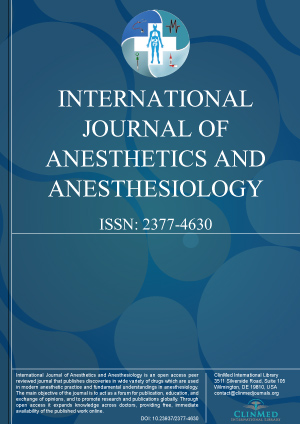Open Access DOI:10.23937/2377-4630/1410108
Sugammadex-Is Cost the Only Drawback?
Michael W Lew, MD and Joseph Chang, MD
Article Type: Letter to the Editor | Indexed Archive: Volume 7
Residual muscle paralysis is an important safety issue, with multiple studies demonstrating an association with increased postoperative complications. The pathophysiology of these complications isn’t difficult to explain. One can only imagine the signs and symptoms in an awake patient (i.e. the panic from not having the strength to take a deep breath or move at full strength; the anxiety of not controlling one’s body movement). A study by the Cleveland Clinic demonstrated that major complica...
Open Access DOI:10.23937/2377-4630/1410107
Massive Subcutaneous Emphysema and Intraoperative Hypercarbia after Transanal Endoscopic Microsurgery (TEMS)
Abhishek Singh, Apala Roy Chowdhury, Ameya Pappu and Puneet khanna
Article Type: Case Report | Indexed Archive: Volume 7
Transanal endoscopic microsurgery (TEMS) is minimally invasive, safe and highly effective treatment modality for resecting small rectal lesion like adenomas, early stage carcinoma and strictures. We describe an unusual case of massive subcutaneous emphysema and hypercarbia secondary to TEMS leading to ventilatory difficulty and post-operative mechanical ventilation. Extra peritoneal insufflation of CO2 at high pressure, for prolonged duration and extent of tissue dissection are some of the predi...
Open Access DOI:10.23937/2377-4630/1410104
Effect of Opioid-Free Anaesthesia on Perioperative Period: A Review
Tatiana Basto and Humberto S Machado
Article Type: Review Article | Indexed Archive: Volume 7
Balanced anaesthesia relies on the administration of opioids in the perioperative period as antinociceptive agents. There is no clear evidence that intraoperative opioids result in reduction of postoperative pain scores. Opioid-free anaesthesia (OFA), combination of various opioids- sparing techniques leading to no administration of intraoperative systemic, neuraxial or intracavitary opioids, arises from the attempt to develop anti-hyperalgesic techniques to improve postoperative pain control. T...
Open Access DOI:10.23937/2377-4630/1410103
Cor Triatriatum Dexter and Patent Foramen Ovale Discovered Following Cardioembolic Stroke
Jacquelin Peck, MD, Nicholas Suraci, MD, Frederick Hasty, MD and Jayanard D'Mello, MD
Article Type: Case Report | Indexed Archive: Volume 7
Cor Triatriatum (CT) is a seldom-reported cardiac anomaly defined by the presence of an abnormal septation within the right or left atrium. Cor triatriatum usually remain asymptomatic until late adulthood, but depending on the severity of septation and location within the atrium the manifestations can vary in presentation. We present a case of cardioembolic cerebrovascular accident in a patient with cor triatriatum dexter and a patent foramen ovale. To our knowledge, no existing case report desc...
Open Access DOI:10.23937/2377-4630/1410105
Intraoperative Activation of Very Wide Range Cold Agglutinins during a Cardiac Bypass Case
Saurin J Shah, MD, Juan C Mora, MD, Shashank S Shettar, MD and John P Pirris, MD
Article Type: Case Report | Indexed Archive: Volume 7
Cold agglutinin disease is a rare form of autoimmune hemolytic anemia mediated mainly by IgM antibodies reacting to surface antigens of the red blood cells at low temperatures causing agglutination and posterior hemolysis on rewarming. Patients with this condition might never be symptomatic, but when they are exposed to hypothermia during cardiovascular procedures, these reactions can be triggered leading to serious organ damage. We describe/discuss a case of a patient with a wide range cold agg...

